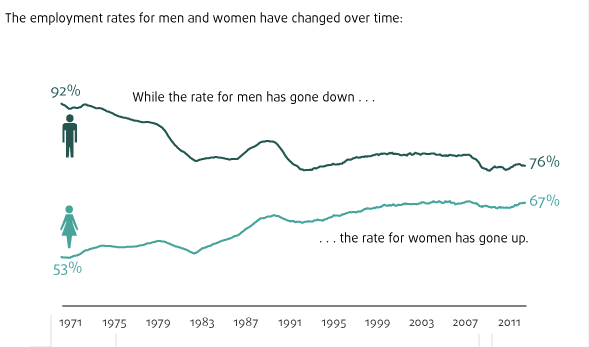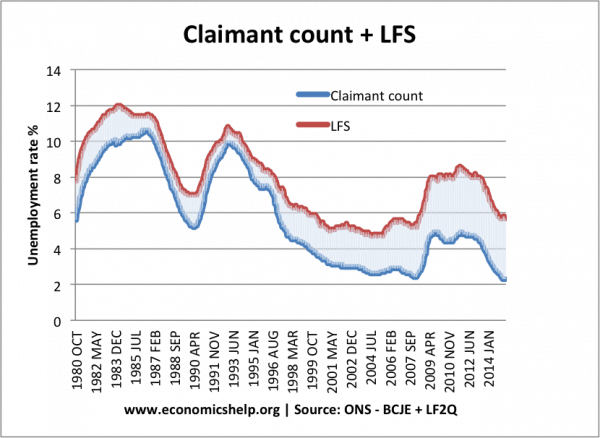Readers Question: To what extent do the official UK figures for unemployment accurately reflect economic reality?
The unemployment rate measures those who are officially seeking work but unable to find employment.
However, the official unemployment rate does not include those who are not working and are classed as economically inactive. For example, economically inactive can include
- People may feel there are no jobs available
- People on sickness and disability benefit
- Family careers.
- Early retirement
- Students
The OECD produced a report in 2019 that if the economically inactive are included – the ‘true level of unemployment rate would rise from 4.6% to 13.2% of the working-age population, not in education’. (link)
Is it fair to include the economically inactive in unemployment?
It is an interesting question of whether the inactive should be included in definitions of unemployment. Most international definitions state a person is unemployed only if they are actively seeking work and unable to find it.
However, it may be that an unemployed worker becomes demotivated by the state of the job market. After a few years of failing to gain employment, they ‘give up on the labour market’ and state they are no longer looking for work but sign on for alternative benefits. If the labour market improved (better jobs and better pay), they would be inclined to re-enter the labour market and actively seek work.
However, the economic inactive may genuinely have no desire or ability to work. They may be incapacitated by sickness or disability, prefer to take early retirement or choose to live on a lower income. If someone is inactive they may or may not have any intention to work.
Official measures of unemployment
The government publish two unemployment statistics – the Claimant count and Labour Force Survey.
- The Labour Force Survey asks 60,000 people whether they are actively seeking work.
- The claimant count is the number of those receiving job seekers allowance.
The labour force is a better guide to unemployment because the claimant count only includes those eligible for benefits.
Another factor to consider is the extent of disguised unemployment. This is when people are not counted as unemployed, but they may be moved on to sickness/disability benefits or work only part-time rather than full time. It can be useful to look at employment statistics as well as unemployment rates.
Claimant count and Labour Force Survey measure of unemployment in the UK
- In Dec 2015, according to the Labour Force Survey, there were 1.69 million unemployed people (5.1% of the working population) – Labour force survey
- In Dec 2015, according to Claimant count, there were 760,000 unemployed 2.2%
- See: UK unemployment
The claimant count suggests we are close to full employment. However, despite these figures, there are many reasons to suggest that this is an underestimate of unemployment.
People excluded from Job Seekers Allowance
The JSA excludes many groups of people from claiming unemployment benefit, even though they are actively seeking work. Examples include:
- A husband or wife whose partner is working and earning above a certain amount. i.e. JSA is means tested depending on a partner’s income. After six months it is also means-tested depending on savings
- People under 18 are not eligible – in theory, they should be on training schemes
- People who are not able/willing to sign on at job centre can lose benefits.
- People over 55 are often excluded.
The claimant count is not a good guide to measuring the real scope of unemployment because many are counted as unemployed, but they are not eligible for benefits.
Labour Force Survey

The Labour Force Survey is done according to internationally agreed criteria by the ILO. This survey is a monthly questionnaire of 60,000 people. It asks them whether they have been actively seeking work and would be able to take work if offered. The ILO method gives a significantly higher figure ( currently 1.69 million Dec 2015) It is worth noting that the ILO questions stick close to the common economic definition of unemployment (actively seeking work) Therefore, this would be a better approximation of unemployment levels in the UK.
This is despite the potential for sampling errors in a survey of 60,000 people; also, people may not tell the truth.
Other factors which influence true levels of unemployment
Economic inactivity
Economic inactivity is when people are considered to have left the labour force. They are neither working or counted as unemployed. Economic inactivity can include long-term sickness and disability, students, early retirement.
In recent years there has been a marked increase in the number of people receiving sickness or disability benefits. These people used to be employed, but, for various reasons are no longer able to work. Rather than be classed as unemployed, they have effectively left the labour force. In one sense, they are not unemployed because they are not seeking work. However, on the other hand, you could argue this economic inactivity is a type of unemployment. Perhaps under different circumstances, they could be working. Often sickness benefits disguise the extent of unemployment in certain areas. For example, many former miners were given sickness benefits, rather than be classed as unemployed when the mines closed down.
On the other hand, the rise in female participation rates has increased the levels of economic activity.
Source: ONS
In the past 40 years, economic inactivity rates have been fairly steady, but in periods of unemployment – it tends to rise, and when unemployment falls – economic inactivity also falls.
This types of unemployment is often known as hidden unemployment.
Disguised Unemployment
Disguised unemployment occurs when people do not have productive full-time employment but are not counted in the official unemployment statistics.
Under-employment index – showing a rise in part-time work 2008-12
For example, a person may want to work 40 hours a week. However, he might only be able to find part-time work. Therefore, he is not classed as unemployed, but at the same time, he doesn’t have a full-time job – we could say he is underemployed.
- People with sickness/disability benefits (but, would be able to do some jobs)
- People doing part-time work.
- Zero hour contracts, where the number of hours worked is less than wanted.
- People forced to take early retirement and redundancy
- Disguised unemployment could also include people doing jobs that are completely unproductive, i.e. they get paid but they don’t have a productive job.
OECD Report
An OECD Report in 2019 stated that if a measure of economic activity is used – the total number of people out of a job who could work would rise from the official level of 1.3 million to almost 4.5 million.
The OECD measure of economic activity would include as unemployed people who do not work and refer to themselves as inactive because they feel no jobs are available. For example, people caring for family and people with health issues.

Possible overestimation of unemployment
It is also possible that some people counted as unemployed are actually working. It is possible that people receive benefits but still work for ‘cash in hand’
However, the criteria are quite strict. Also, the Labour Force survey doesn’t rely on the numbers receiving benefits.
UK unemployment and output gap

A feature of the 2008-13 recession is that unemployment has fallen quicker than previous recessions. This is unusual in that unemployment is usually a lagging indicator (takes time). For example, after the 1981 recession, it took many years to bring unemployment down.
This is due to factors such as
- Lower wage growth making employment cheaper
- Falling / stagnant productivity – meaning more workers are needed
- More flexible labour markets, firms able to employ on cheaper part-time contracts
- A fall in the natural rate of unemployment.
See also: UK Unemployment mystery.
Related





Finding a job is hard at the moment. I think it’s going to get harder as the years go by and more of the employed become unemployed.
unemployment the wreck of economy and abject poverty,divorce streak and many catalyst of doom
The economic inactivity rate since 1970 is interesting. Apart from a relatively brief rise in unemployment in the early 80s and a relatively brief drop in the late 80s, we see an almost constant and slow drop over time. It makes me wonder how much impact the changes of government have had, because the decline seems to be constant (apart from relatively brief blips) and that would suggest to me that it was structural, and nothing to do with the policies of governments, who are like weathervanes, blown about by the winds of the global economy. It seems to make no difference as to who is in charge at any given time, yet they all take the credit, or assign the blame to their opponents, for everything.
Some years ago I read that the definition of full employment is as follows:-
One hundred thousand people out of work in constant roll over and never the same individuals unemployed all of the time signing on. The book went on to state that number is all that is required in order to control inflation-and not a million or more.
I am old enough to recall the TV in the 1960’s revealing the slow growth of the unemployed statistics. This was on a weekly basis. I remember when it went from approximately 200,000 to 500,000.
4.5 million out of work is probably correct.
My total time in unemployment was 22 years. Eighteen of which were continuous. I am employed and doing all right. I was lucky.
I was never idle. And no I did not work in the black economy.
I was also a Carer for four years.
All of the UK’s Governments have been dogmatic and ineffectual in regard to economics and social policy.
Those of you who are unemployed and reading this take heart.(I am 66 years.)
There is no ‘natural rate of unemployment’.
It is however unnatural to have unregulated economics and to have ‘de-industrialised’.
Good luck.
Did you mean family carers in the list of economically inactive
Yes. https://www.economicshelp.org/blog/160372/economics/economic-inactivity/